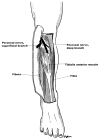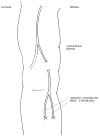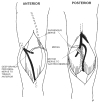Clinical application of sensory protection of denervated muscle
- PMID: 18976091
- PMCID: PMC3409866
- DOI: 10.3171/JNS/2008/109/11/0955
Clinical application of sensory protection of denervated muscle
Erratum in
- J Neurosurg. 2009 Jan;110(1):197
Abstract
Following proximal peripheral nerve injury, motor recovery is often poor due to prolonged muscle denervation and loss of regenerative potential. The transfer of a sensory nerve to denervated muscle results in improved functional recovery in experimental models. The authors here report the first clinical case of sensory protection. Following a total hip arthroplasty, this patient experienced a complete sciatic nerve palsy with no recovery at 3 months postsurgery and profound denervation confirmed electrodiagnostically. He underwent simultaneous neurolysis of the sciatic nerve and saphenous nerve transfers to the tibialis anterior branch of the peroneal nerve and gastrocnemius branch from the tibial nerve. He noted an early proprioceptive response. Electromyography demonstrated initially selective amelioration of denervation potentials followed by improved motor recovery in sensory protected muscles only. The patient reported clinically significant functional improvements in activities of daily living. The authors hypothesize that the presence of a sensory nerve during muscle denervation can improve functional motor recovery.
Figures





References
-
- Bain JR, Veltri KL, Chamberlain D, Fahnestock M. Improved functional recovery of denervated skeletal muscle after temporary sensory nerve innervation. Neuroscience. 2001;103:503–510. - PubMed
-
- De Luca CJ, Bloom LJ, Gilmore LD. Compression induced damage on in-situ severed and intact nerves. Orthopedics. 1987;10:777–784. - PubMed
-
- Edwards BN, Tullos HS, Noble PC. Contributory factors and etiology of sciatic nerve palsy in total hip arthroplasty. Clin Orthop Relat Res. 1987;218:136–141. - PubMed
Publication types
MeSH terms
Grants and funding
LinkOut - more resources
Full Text Sources

